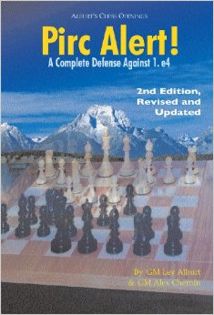Pirc Alert
A complete Defense Against 1.e4
Alex Chernin, Lev Alburt

[NOTE: This review is for the first edition. A 2nd revised edition is now available]
Pirc Alert is book that I havent finished examining (so much material), but it seems to be much better as an instructional work than as a theoretical one. The core of the book is Chernins. He is responsible for all of the Games and Ideas section, covering approximately 180 pages. And the Theoretical Variations section, about 225 pages, is stated as being by Alex Chernin, assisted by Lev Alburt. It is important to note (and never mentioned, I believe) that this is a repertoire book for Black, not a comprehensive treatment of the Pirc. There is only one line offered for Black against each of Whites options, with the unusual exception that three choices are given in answer to the relatively rare g3 line. Thus one plays 5 …c5 against the Austrian Attack (3.Nc3, 4.f4, 5.Nf3), for example, and not 5…0-0; similarly, your move against the Classical (3.Nc3, 4.Nf3, 5.Be2, etc.) is 6…Bg4.
As a bonus, related Modern Defense positions (1…g6 without …Nf6) are given throughout the ideas section, but only sporadically analyzed, and usually not included in the variations table at the back of the book. Such 1…g6 lines offer a way to get to desired positions or avoid unwanted variations. Nevertheless, actual concrete analysis is given for just a few Modern lines involving 4.Bg5 and 4.Be3; and oddly enough, after a long chapter on the Pirc with 4.Be3, the authors offer Black two other unique Modern Defense solutions!
I went back to my old review of Nunn and NcNabs THE ULTIMATE PIRC to check on the Classical line that I analyzed there. Alburt and Chernin repeat that books mistake of assuming that a Kasparov blitz game versus a lesser opponent represents best play in what is arguably the main line of the whole opening! One assumes that the game wasnt even looked at, because White seems to be clearly better at the point where they stop (it is assessed as equal). Regardless of the assessment, the authors should have checked this critical variation. See Pirc expert Randy Bauers lengthy discussion of missing systems and problems with analysis on his book review page. One of Randys main points is that Alburt and Chernin dont seem to have looked at other sources much, especially Nunn and McNab. Despite some very fine original analysis by Chernin, the analytical section is generally disappointing, especially given Chernins expertise not only in this opening but in opening theory generally.
Okay, thats the bad news. But for some players the good news may by itself outweigh everything else. I find the ideas and themes section of the book incredibly instructive and well thought out. Instead of a mere presentation of a few diagrams with short thematic comments (such as I myself gave in my Benoni book, for example), Chernin treats every main Pirc idea thoroughly and enthusiastically. He uses many diagrams of typical positions and then verbally analyses the actual continuations at length in terms comprehensible to any post-beginner. The number and variety of these well-chosen examples over the 180 pages is more than impressive. Talk about ideas behind the chess openings by comparison, one has to laugh at superficial and misleading attempts such as Fines, even for his time. This is truly quality stuff from a knowledgeable grandmaster.
In conclusion, I think that for mid-level readers, especially those beginning or wanting a user-friendly tutorial on the Pirc, the complete and detailed treatment of variations given by Nunn & McNab will probably not be as important as the extraordinary instructiveness of Pirc Alert. The superb Themes and Ideas section could be a book in itself; it is easily the best example Ive seen of this idea-based approach. Just be warned that the analytical section is choppy, has holes, and will probably not satisfy an experienced Pirc player.
